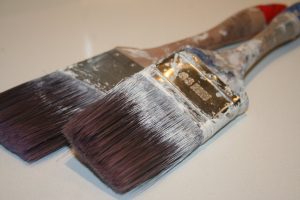 The old saying tells us that “a craftsman is only as good as his tools.” While this might not be an absolute and perfect law of nature, it does bear true in many circumstances. When performing interior painting on your home, it is important to choose a paint brush and roller with care in order to help produce great results. The main factors to consider are expense, bristle material, quality ferrule, handle comfort, width and angle.
The old saying tells us that “a craftsman is only as good as his tools.” While this might not be an absolute and perfect law of nature, it does bear true in many circumstances. When performing interior painting on your home, it is important to choose a paint brush and roller with care in order to help produce great results. The main factors to consider are expense, bristle material, quality ferrule, handle comfort, width and angle.
Should I Buy a Cheap Brush or a High-Quality Paint Brush?
Painting contractors recommend using high-quality paint brushes for every job, owing to two main factors. First, the quality of your brush will make a project go more quickly and produce better results. Secondly, a more expensive brush will last longer, so you will not need to buy another paint brush as soon. In the end, between saved time and fewer brushes, you actually save money by buying an expensive brush. After all, with all the money you are saving when you do it yourself, you might as well spend the money on a better paint brush.
Should I Use Natural or Synthetic Fiber Brush?
Most interior and exterior painting takes place with water-based acrylic/latex paints, and the best type of bristle for this type of paint is definitely synthetic fiber. Use a nylon brush, as this will have better paint flow with this type of paint. If you are using oil-based paints, go with a natural fiber, such as hog’s hair or ox hair. Paint brushes with a blend of nylon and polyester can actually be used with latex or oil-based paints.
What Is a Quality Ferrule?
The ferrule is the metal band that connects the bristles to the handle. Make sure your brush has a metal ferrule, and that it is firmly attached to the handle. Also, look for a ferrule made from a non-rusting metal.
Should I Get a Wood-Handled Brush or a Plastic-Handled Brush?
Most painting professionals prefer wooden-handled paint brushes for comfort and long-term use. This is entirely a matter of preference, however, and each person should choose a handle that feels comfortable for hours of careful work. This is a good time to mention that the brush should also be light to prevent fatigue. It may seem strange to think of painting fatigue, but once you’ve held a paintbrush for a few hours, it can feel surprisingly burdensome.
How wide of a paintbrush should I get?
Most interior and exterior painting projects will require more than one brush. Use a 3-4 inch brush for cutting in long, straight lines on open sections of wall. Also keep a 1 1/2 inch brush handy for use along trim and in tighter spaces.
Should I Get a Straight or an Angled Paintbrush?
Both! Your smaller brush should be angled, making it easier to paint details and reach in corners, while your wider brush should be straight, giving a more consistent cut line on long, open edges. Something else to watch for is that the brush is chiseled, meaning that the bristles in the center are slightly longer than those at the edges. Chiseled brushes are good, creating a smooth dynamic of paint flow and application.
Read these tips if you are thinking about hiring a painting contractor.
A.G. Williams is a residential and commercial painting company, serving Connecticut and New York. Call us for painting services in Sleepy Hollow, Harrison, Norwalk, Milford, Scarsdale and Chappaqua.